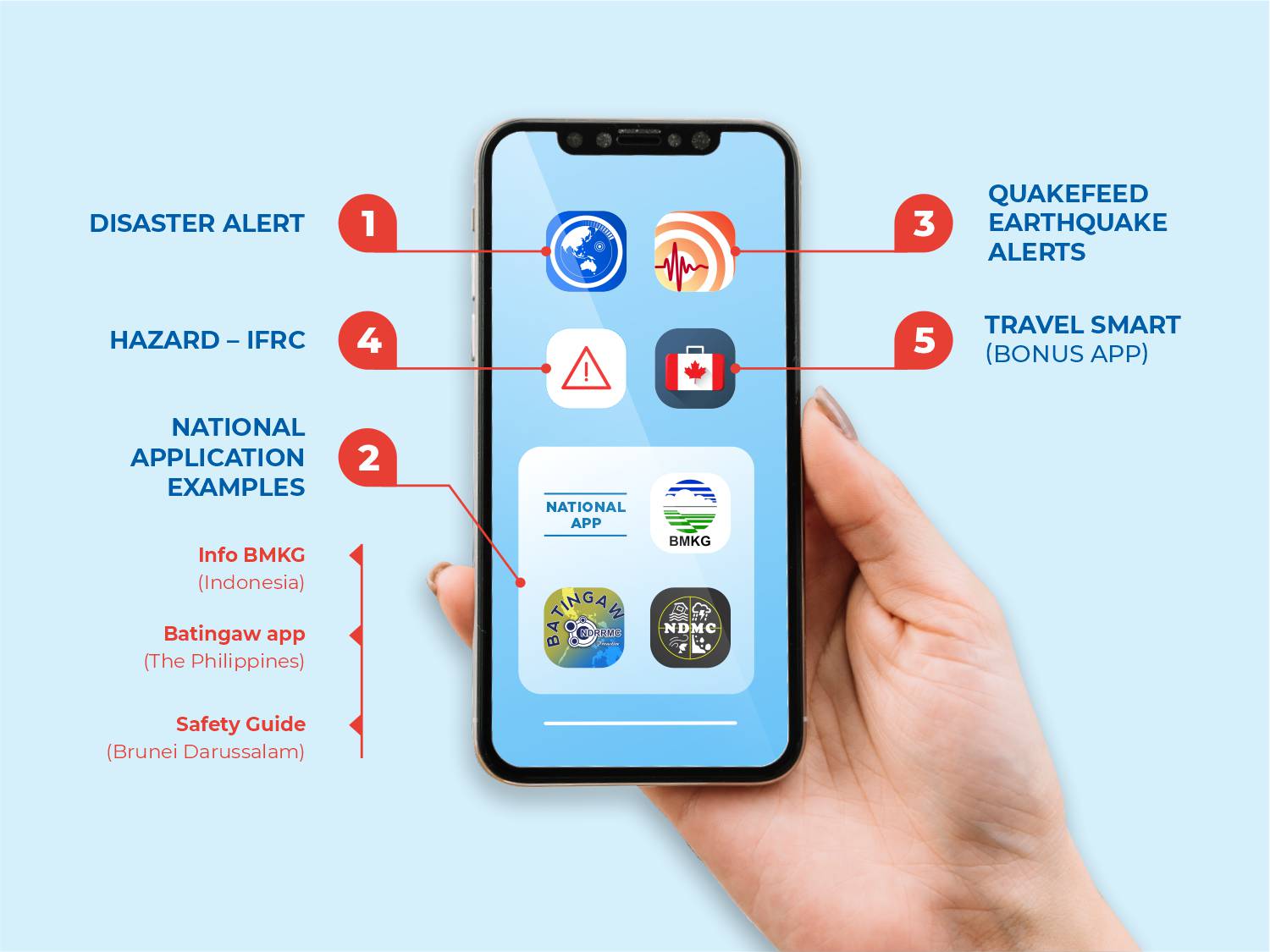
5 USEFUL APPS
FOR DISASTER-PREPAREDNESS AND RESPONSE
Living in the ASEAN region requires residents to equip themselves with a range of helpful technologies that can provide support to mitigate hazards that may arise under any circumstances. These days, technology is handy for receiving alerts and information on disasters and emergency. Increasing ease of access to information is important, as the ASEAN region sits on the Pacific “Ring of Fire”, leaving it prone to the full array of natural hazards. There are a range of applications you can use to receive disaster notifications, support your preparation, and inform you what to do during a critical event.
1. DISASTER ALERT
Developed by the Pacific Disaster Center (PDC) in Hawaii, the United States, this app allows the users to search the locations of current disasters, including earthquakes, tsunamis, volcanic eruptions, storms, landslides, floods and forest fires. And recently, the app has also included tracking the spread of a major virus outbreak. Supported by the DisasterAWARE platform (also developed by the PDC), Disaster Alert provides GPS-based notifications, also allowing users to see other details and locations that are dangerous.
2. NATIONAL APPLICATION EXAMPLES
Info BMKG (Indonesia)
The Indonesian Meteorology, Climatology and Geophysics Agency (BMKG) official app “Info BMKG”, offers features such as earthquake notifications, early warning weather alerts, and informations. Users can also get information about weather forecasts based on location. For earthquake information, all registered earthquakes can appear as notifications, complete with the epicentre location and its distance from the user.
Batingaw app (The Philippines)
Batingaw, a Tagalog word for “siren”, is a pro-active, comprehensive and rational disaster management mobile application adopted by the Office of Civil Defence (OCD) and National Disaster Risk Reduction and Management Council (NDRRMC) as a communication tool to help reduce and mitigate the disastrous effects of natural and human-made hazards on vulnerable communities. It was developed by Smart Communications, Inc. (Smart) in cooperation with the OCD and the NDRRMC. It highlights the need for tools that will not only strengthen public awareness on the importance of disaster preparedness, but also facilitate a nationwide system for disaster response and management.
Safety Guide (Brunei Darussalam)
This app provides guidelines to understand the nature of natural and man-made disasters; early warning signs and specific action plans to various emergency situations for individuals and the community as a whole. This app is based from the book published by the Brunei Darussalam National Disaster Management Centre in 2013 titled ‘Buku Panduan Asas Kecemasan dan Keselamatan Awam’.
3. QUAKEFEED EARTHQUAKE ALERTS
This free app is intended specifically for iOS users who have iPhones and iPads. As the name implies, the app is intended to inform users about earthquake occurrences. So far, it highlights earthquakes from M1.0 on the Richter scale in the USA, and M4.5 in other countries.
4. HAZARD – IFRC
Disaster Preparedness in Your Pocket. The app states that it provides instant access to the information you need to know to prepare for and respond to the impact of a range of hazards, using an alert system feature that provides official updates and warnings from alerting agencies. Hazard also allows you to prepare your homes and family for disasters, find help, and let others know you are safe.
In the ASEAN region, the app is currently supported by Red Cross and Red Crescent National Societies from Indonesia, Myanmar, the Philippines and
Viet Nam.
5. TRAVEL SMART (BONUS APP)
While Global Affairs Canada created this app, don’t let that stop you downloading it if you live elsewhere. Travel Smart app provides essential preparedness and emergency information about countries all over the world. A few highlights include locations of local emergency contacts and embassies, 24-5 alerts, estimated wait times at borders, historical data on storm seasons and natural disasters, transmittable diseases and outbreaks, higher risk areas of towns for tourists, and much more.
Written by : Ina Rachmawati

